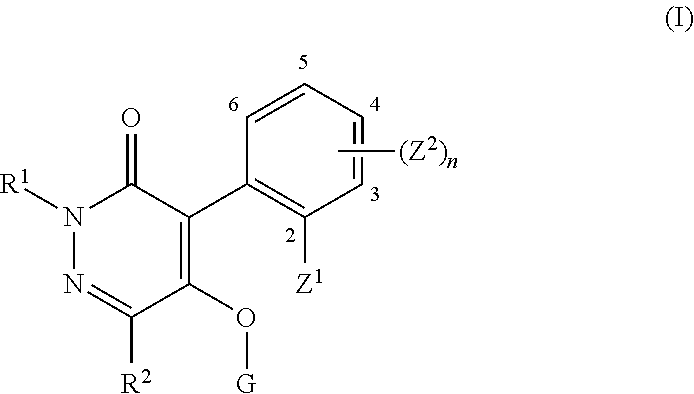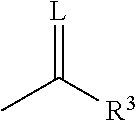Herbicidal composition
- Summary
- Abstract
- Description
- Claims
- Application Information
AI Technical Summary
Benefits of technology
Problems solved by technology
Method used
Image
Examples
production example 1
[0219]A mixture of 3.193 g of 4-(2-ethylphenyl)-5-methoxy-2-methyl-3(2H)-pyridazinone [compound II-1], 50 mL of water, 4.657 g of potassium hydroxide (purity: 85%) and 5 mL of 1,4-dioxane was heated under reflux for 36 hours. The reaction mixture was cooled. To the reaction mixture, concentrated hydrochloric acid, 10 mL of water and 100 mL of ethyl acetate were added. Insoluble matters in the mixture were removed by filtration and the filtrate was made phase-separated. The organic layer was washed sequentially with water and an aqueous saturated sodium chloride solution, dried over anhydrous magnesium sulfate and then concentrated. The residue was washed with an ethyl acetate-hexane mixed solvent (1:2) to obtain 2.050 g of 4-(2-ethylphenyl)-5-hydroxy-2-methyl-3(2H)-pyridazinone [compound I-a-1] as a colorless crystal.
[0220]The compound I-a-1 and other compounds produced in the same manner as Production Example 1 are shown in Table 1. The compound represented by the formula (I-a):
TAB...
production example 2
[0221]Under a nitrogen atmosphere, a solution of 1.9 g of ethyl 2-[2-(2,6-diethyl-4-methylphenylacetyl)-2-methylhydrazono]propanoate [compound VI-2] in 55 mL of toluene was added dropwise to 13 mL of a solution (1 mol / L) of potassium tert-butoxide in tetrahydrofuran at room temperature over about 1 hour. This mixture was stirred at room temperature for 30 minutes. The reaction mixture was concentrated under reduced pressure. To the resultant residue, 30 mL of ice water was added, followed by washing with tert-butyl methyl ether (20 mL×2). To the aqueous layer, 1.6 g of 35% hydrochloric acid was added, followed by extraction with ethyl acetate (20 mL×3). The organic layer was washed with an aqueous saturated sodium chloride solution (20 mL×2), dried over anhydrous magnesium sulfate and concentrated under reduced pressure. The resultant residue was subjected to silica gel column chromatography (ethyl acetate:hexane=1:3) to obtain 0.76 g of a solid. The solid was washed with cold hexan...
production example 3
[0223]To 0.326 g of the compound I-a-1, 12 mL of tetrahydrofuran and 0.40 mL of triethylamine were added. To this mixture, 0.25 mL of benzoyl chloride was added under ice cooling. The mixture was stirred under ice cooling for 10 minutes and then stirred at room temperature for 3 hours. To the reaction mixture, 30 mL of water was added, followed by extraction twice with 30 mL of ethyl acetate. The organic layer was washed with an aqueous saturated sodium chloride solution, dried over anhydrous magnesium sulfate and concentrated. The residue was subjected to silica gel column chromatography (ethyl acetate:hexane=1:2, 2:1) to obtain 0.463 g of 5-benzoyloxy-4-(2-ethylphenyl)-2-methyl-3(2H)-pyridazinone [compound I-b-1] as a colorless oil.
[0224]The compound I-b-1 and other compounds produced in the same manner as Production Example 3 are shown in Table 3. The compound represented by the formula (I-b):
TABLE 3MeltingNo.R1R2Z1(Z2)nG3point / ° C.I-b-1MeHEt—COPh*I-b-2MeHEt—COMe69-70I-b-3MeHEt—C...
PUM
 Login to View More
Login to View More Abstract
Description
Claims
Application Information
 Login to View More
Login to View More - R&D
- Intellectual Property
- Life Sciences
- Materials
- Tech Scout
- Unparalleled Data Quality
- Higher Quality Content
- 60% Fewer Hallucinations
Browse by: Latest US Patents, China's latest patents, Technical Efficacy Thesaurus, Application Domain, Technology Topic, Popular Technical Reports.
© 2025 PatSnap. All rights reserved.Legal|Privacy policy|Modern Slavery Act Transparency Statement|Sitemap|About US| Contact US: help@patsnap.com



